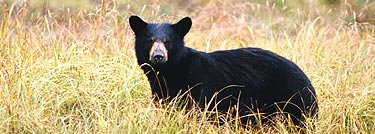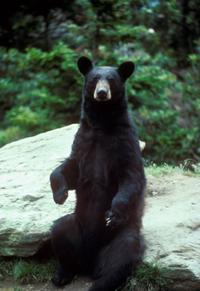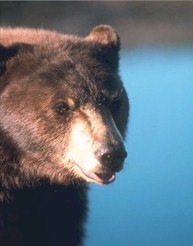|
Bears And Bigfooting (Safety
in bear country)
By Chuck Adinolfi (BigDaddy)
 Let me begin by saying; I have been studying bears and bear activity for 25
years, It’s a hobby of mine and I read everything I can find about it. Let me begin by saying; I have been studying bears and bear activity for 25
years, It’s a hobby of mine and I read everything I can find about it.
In our search for Bigfoot / Sasquatch, we will be conducting expeditions and
other operations in areas with dense bear populations. While hiking and camping
in these areas is reasonably safe and there aren’t many ill-fated encounters
with bears in the North East, it should be pointed out that our activities will
potentially put us in harms way, as far as bears are concerned.
 Many of us will find ourselves in bear country, on the ground, at night, with
food sources close by (bate for Bigfoot), while trying to be as quiet as
possible and without the use of lights. Combine this with the fact that if we
hear an animal approaching, we will want to let it get as close as possible in
case it’s the ‘big guy‘, so we can snap a photo or collect other evidence. This
means surprising the animal and bears are known to not like being surprised.
About the only thing I can think of that might do more to guarantee a bad bear
encounter would be to find a bear cub and trying to play soccer with it as the
ball. This is not to say that an encounter with a bear will be violent or even
unpleasant. Many of us will find ourselves in bear country, on the ground, at night, with
food sources close by (bate for Bigfoot), while trying to be as quiet as
possible and without the use of lights. Combine this with the fact that if we
hear an animal approaching, we will want to let it get as close as possible in
case it’s the ‘big guy‘, so we can snap a photo or collect other evidence. This
means surprising the animal and bears are known to not like being surprised.
About the only thing I can think of that might do more to guarantee a bad bear
encounter would be to find a bear cub and trying to play soccer with it as the
ball. This is not to say that an encounter with a bear will be violent or even
unpleasant.
I am really not trying to frighten anyone here but there are some facts that you
need to know. While an adult black bear is roughly half the size of a grizzly,
in an attack, the black bear is 60 times more likely to kill it’s victim. Bears
are predators of opportunity and if a black bear attacks, it may make up it’s
mind that it might as well eat you. This being more prevalent in the behavior of
black bears, is why they are more likely to kill.
Our activities will be contrary to safe behavior in bear country, so there are
some things to know to keep yourself relatively safe.
A small (skinny) bear should not be taken lightly. A good many of the deaths
caused by black bears were by bears in the 120 lb. range
When you chose your position, try to locate yourself near a good “bear tree”.
What’s a “bear tree”? Well, it is a tree that you can easily climb but a bear
can not. It is better to have chosen your “bear tree” before you need it. Keep
in mind that a black bear can climb a tree better and faster than you could ever
hope to. Now, to pick the right tree; Chose a tree that will be too skinny for a
bear to get a grip on for climbing but fat enough not to be pushed over by a
large bear. About 6” to 10” in diameter without branches below 5 feet should do
just fine. It might even help if you give climbing it a try to make sure it is
suitable for you and that you can get up it in a reasonably quick manner.
 A bear can sometimes be intimidated. This can be accomplished by shooing the
bear with a firm voice (“Shoo bear, shoo, go away bear”) and trying to make
yourself look as large and imposing as possible. Keep in mind that you want to
intimidate the bear, not frighten it into thinking it needs to defend itself.
While you are doing this, a slow backward retreat is in order. One of the worst
things you can do is run away. This is an almost sure way to trigger an attack.
It is instinctive and reflexive for a bear to pursue something that is running
from it. If you run the predatory instinct kicks in and the next thing you know,
you’re on the ground with a bear on top of you. A bear can sometimes be intimidated. This can be accomplished by shooing the
bear with a firm voice (“Shoo bear, shoo, go away bear”) and trying to make
yourself look as large and imposing as possible. Keep in mind that you want to
intimidate the bear, not frighten it into thinking it needs to defend itself.
While you are doing this, a slow backward retreat is in order. One of the worst
things you can do is run away. This is an almost sure way to trigger an attack.
It is instinctive and reflexive for a bear to pursue something that is running
from it. If you run the predatory instinct kicks in and the next thing you know,
you’re on the ground with a bear on top of you.
If intimidation fails and the bear continues to advance and you have bear spray,
it is time to use it and if you don’t (have bear spray), it is time to get up
your “bear tree” if time allows, if not, it is time to prepare to defend
yourself. If you have a weapon of any kind, get it ready.
 In the case of an attack (black bear), at first, be defensive, the fetal
position, with your fingers laced behind your neck is best. A bear will
naturally attack the face and head. This is instinct, as a bear sees a face as a
weapon and wants to take it out of action. If the bear begins to bite you, it is
time to fight for your life. The snout (nose) is the most sensitive part of a
bears body (and the most exposed). A stout whack on a bears nose with something
like a stick, a pair of binoculars or even a fist (if that’s all you have handy)
could very well send even a large bear into retreat. There is no guarantee this
will do the trick and save your life or keep you from a bad mauling but in a
jam, it’s better than nothing and has been known to work. Keep in mind that if
you do whack a bear in the nose, you don’t want to do it like you were
chastising a dog for getting into your bag of Doritos but you want to hit this
bear like you were trying to knock its nose off its face. The sensations (pain)
created by a blow like this can be overwhelming to a bear. Being a predator, a
bear doesn’t want to risk injury to its tools for making a living and the nose
is a central part of this for a bear. In the case of an attack (black bear), at first, be defensive, the fetal
position, with your fingers laced behind your neck is best. A bear will
naturally attack the face and head. This is instinct, as a bear sees a face as a
weapon and wants to take it out of action. If the bear begins to bite you, it is
time to fight for your life. The snout (nose) is the most sensitive part of a
bears body (and the most exposed). A stout whack on a bears nose with something
like a stick, a pair of binoculars or even a fist (if that’s all you have handy)
could very well send even a large bear into retreat. There is no guarantee this
will do the trick and save your life or keep you from a bad mauling but in a
jam, it’s better than nothing and has been known to work. Keep in mind that if
you do whack a bear in the nose, you don’t want to do it like you were
chastising a dog for getting into your bag of Doritos but you want to hit this
bear like you were trying to knock its nose off its face. The sensations (pain)
created by a blow like this can be overwhelming to a bear. Being a predator, a
bear doesn’t want to risk injury to its tools for making a living and the nose
is a central part of this for a bear.
Bears have better weapons but we have a much bigger brainpan and thumbs. Keeping
your wits about you and using your dexterity can make all the difference as to
who eats who. (I have many great recipes for bear.)
A mistake I see way too many people make is to wipe their hands on their pants
after eating. I believe this is why being bitten in the thighs is so common in
bear attacks (bears smell the food). Wash your hands after you eat. (and before
wouldn’t hurt either)
A man’s best friend (dog) can get him hurt or killed in bear country. A “bear
dog” needs to be specially trained to not return to its master for help. A
frightened dog, or one that is being bested by a bear will return to its master
for protection and the bear will likely follow. This is why dogs are required to
be on a leash when on the trails in the Adirondacks and other recreational
areas. Even the Karelian breed needs to be specially trained for handling and
hunting bears. I am personally of the opinion that dogs are not a very good tool
in searching for Bigfoot anyway.
If you have any questions, please don’t hesitate to ask.
Be careful and use but don’t lose your head.
.jpg)
The photos appear here under
the fair use
for educational purposes of copyright material.
|